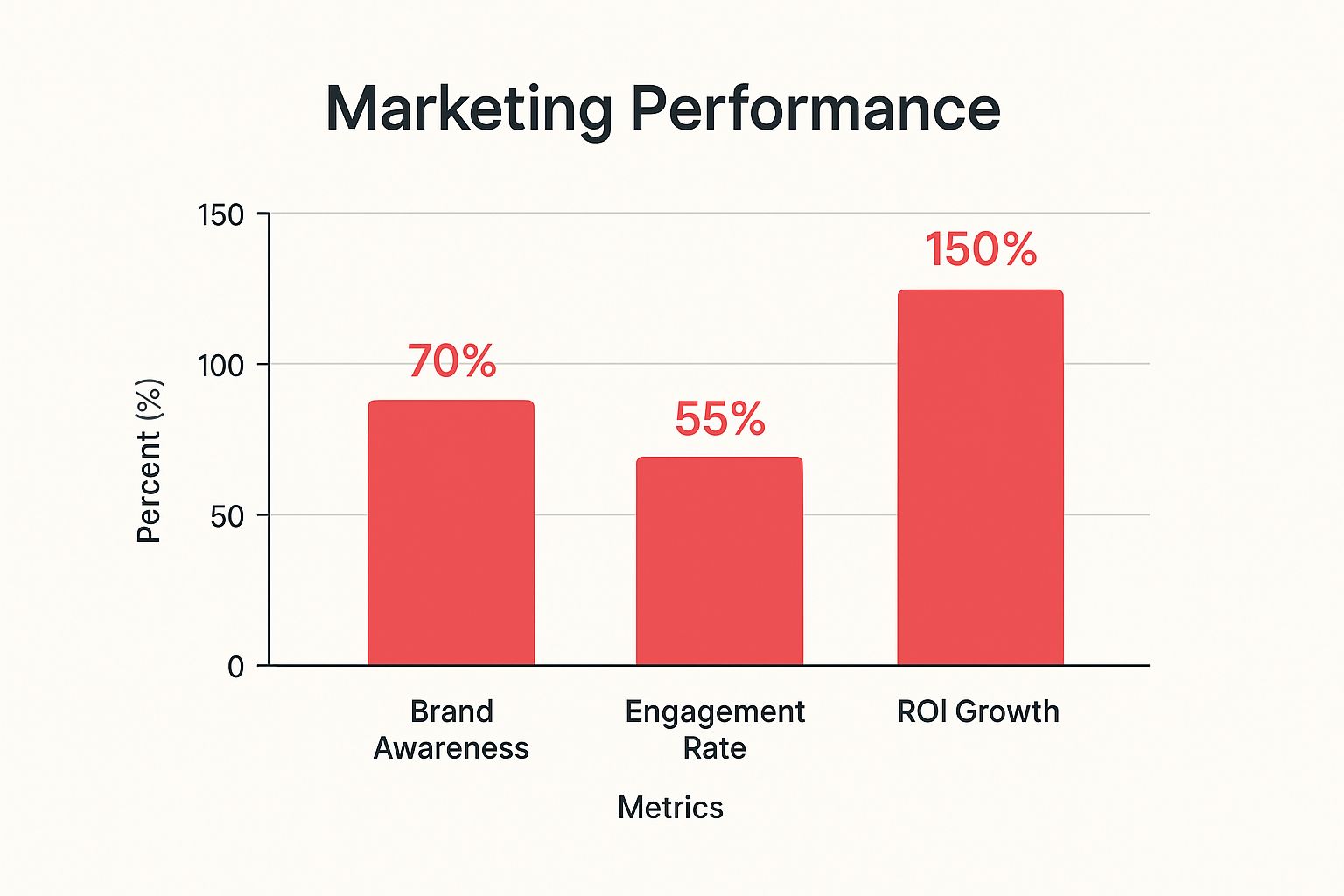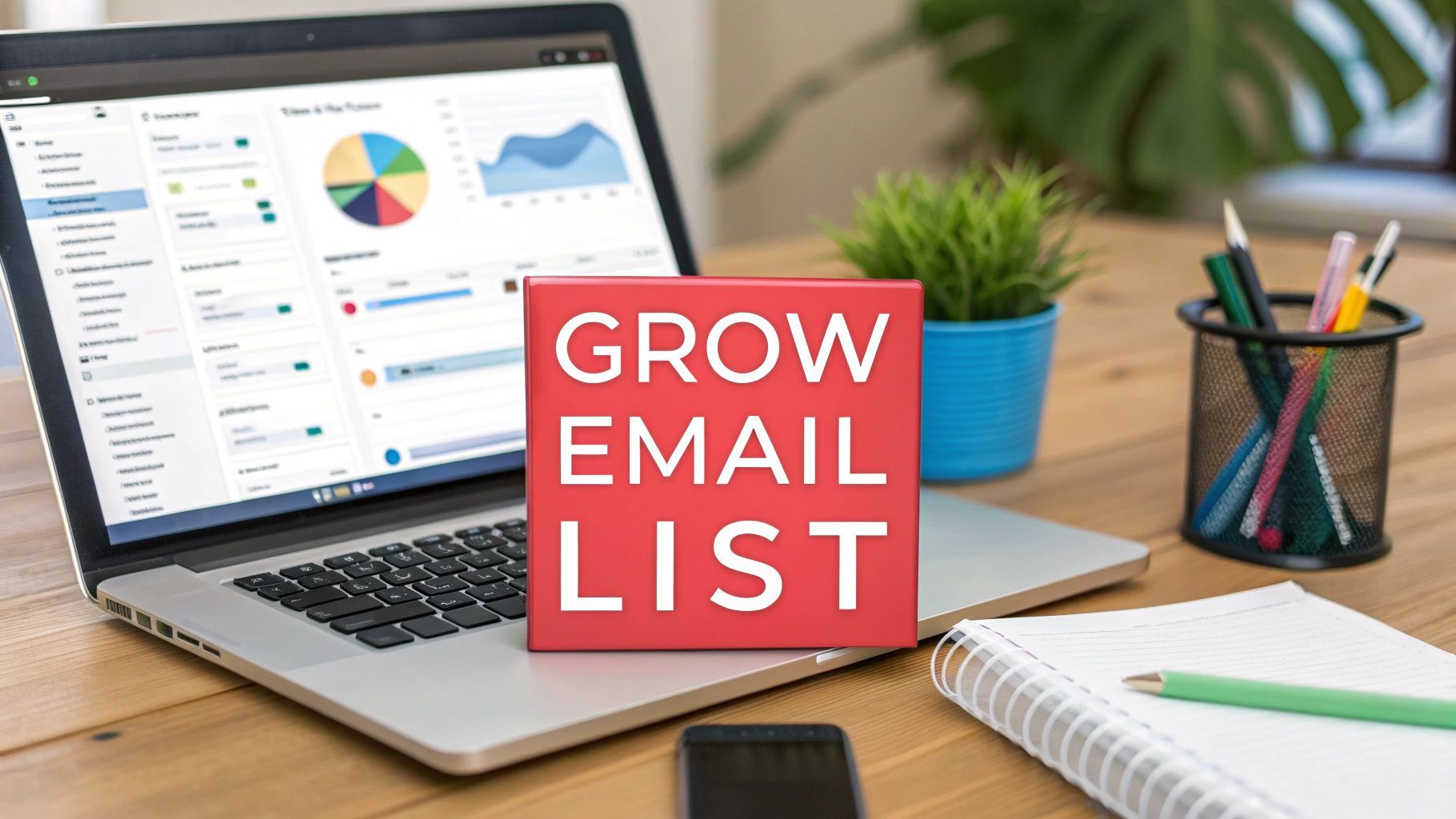Effective Social Media Management for Businesses | Boost Growth
Social media management is so much more than just throwing posts out into the digital ether. It’s the craft of creating, scheduling, analysing, and engaging with everything you share online, all with a clear business purpose in mind. It's about turning a social feed into a powerful tool for brand building, community connection, and ultimately, driving sales.
Building Your Foundation for Social Media Success
Long before you hit ‘publish’ on your first post, the real work begins. Proper social media management is built on a solid strategic foundation, a blueprint that guides every single action you take. Without a plan, even the most beautifully designed content can completely miss the mark, wasting your time, money, and energy.
To build an online presence that actually delivers results, you’ve got to start by developing a robust social media strategy. This means getting serious and moving beyond vague ambitions like "getting more followers" to defining exactly what success looks like for your business.
Set Meaningful Business Objectives
Your social media goals must be a direct reflection of your wider business objectives. What are you actually trying to achieve? Are you aiming to boost online sales, get more people through the door of your physical shop, or position your brand as the go-to expert in your field?
Each of these goals demands a completely different game plan. An ecommerce brand, for example, will be laser-focused on metrics like click-through rates and conversions from their social ads. A local café, on the other hand, might care more about engagement on posts about daily specials and tracking mentions from happy customers in the area.
A great rule of thumb is to make your objectives SMART: S pecific, M easurable, A chievable, R elevant, and T ime-bound. Don't just "increase engagement." A much stronger objective is to "achieve a 5% average engagement rate on Instagram posts within the next quarter."
Precisely Identify Your Target Audience
This might be the most crucial piece of the puzzle. Understanding who you're talking to goes way beyond basic demographics like age and location. You need to get under the skin of their online behaviour.
Where do they spend their time online? What kind of content makes them stop scrolling? What are their biggest frustrations, and how can your business be the solution they’re looking for?
Creating detailed customer personas can be a game changer here. Think about:
- Their go-to platforms: Are they visual scrollers on Instagram and TikTok, or are they hunting for professional knowledge on LinkedIn?
- Their online habits: When are they most likely to be active? Do they prefer quick videos, in-depth articles, or interactive polls?
- Their motivations: What problem are they trying to solve that your product or service is perfect for?
Getting this level of understanding allows you to create content that feels personal and builds a genuine connection. This is absolutely vital in a crowded space like the UK market. As of early 2025, an astonishing 79% of the UK population are active social media users, which is miles ahead of the global average. With 54.8 million users on YouTube and 38.3 million on Facebook , the potential is huge, but cutting through that noise requires a smart, audience-first approach. Learn more about the UK social media landscape from Metricool.
Choosing the Right Platforms for Your Business
Trying to be everywhere on social media is a classic rookie mistake. It’s a fast track to burnout, not results. The secret to effective social media management isn’t about shouting into every corner of the internet; it's about having meaningful conversations where your customers are already gathered.
Think about it. A high-end B2B software firm trying to go viral on TikTok is probably just wasting time and money. Likewise, a trendy fashion brand completely ignoring a visual powerhouse like Instagram is leaving a massive opportunity on the table. Your job is to find that sweet spot where your brand, your audience, and the platform’s vibe all click into place.
Pinpoint Where Your Audience Is Active
Before you post a single thing, you need to know where your people hang out online. It’s not just about which platforms they have an account on; it’s about where they genuinely spend their time.
Research shows that UK adults spend around 1 hour and 37 minutes on social media every single day, juggling an average of 6.4 different platforms a month. That’s a lot of scrolling. Your customers are definitely out there, but you need to figure out which of those platforms they turn to for what. You can get a deeper look at this in the breakdown of UK social media statistics from Talkwalker.
Ask yourself these simple questions to get started:
- Who are you really talking to? A strategy aimed at Gen Z is going to feel worlds apart from one targeting established B2B professionals. For business-to-business, LinkedIn is still the undisputed king, while younger audiences are discovering what’s new and cool on TikTok and Instagram.
- What’s your content style? If your team excels at creating stunning visuals and slick videos, platforms like Instagram and YouTube should be your first port of call. But if your strength is in thought leadership and detailed industry chat, LinkedIn or even niche subreddits on Reddit could deliver far better results.
- Where are your competitors playing? A quick analysis of where your rivals are active (and, more importantly, getting engagement) can provide some brilliant clues. But don't just copy them—look for the gaps they’re missing.
To help UK businesses make this choice, we've put together a simple framework.
Platform Selection Framework for UK Businesses
| Platform | Primary Audience (UK) | Best For | Content Format Focus | Business Goal Alignment |
|---|---|---|---|---|
| Gen X & Millennials (broad demographic) | Community building, local business, lead generation | Video, images, text updates, stories | Brand awareness, lead gen, customer service | |
| Gen Z & Millennials (under 35s) | Visual storytelling, influencer marketing, ecommerce | High-quality images, Reels, Stories | Product discovery, brand building, engagement | |
| Professionals, B2B decision-makers (25-55) | B2B networking, thought leadership, recruitment | Articles, professional video, text posts | Lead generation, industry authority, hiring | |
| X (Twitter) | Broad, news-focused audience (25-49) | Real-time updates, customer service, brand voice | Short text, polls, images, video clips | Public relations, customer engagement, news |
| TikTok | Gen Z & young Millennials (under 25s) | Viral trends, user-generated content, brand personality | Short-form vertical video | Top-of-funnel brand awareness, engagement |
| Predominantly female, homeowners, planners | Visual discovery, driving website traffic | High-quality vertical images (Pins), Idea Pins | Ecommerce sales, inspiration, traffic | |
| YouTube | All demographics (highly diverse) | In-depth tutorials, product reviews, brand storytelling | Long-form and short-form video | Education, building authority, search visibility |
This table isn't about picking one and ignoring the rest. It's about prioritising where you invest your primary effort to get the best return.
Crafting a Consistent and Authentic Brand Voice
Once you've zeroed in on your core platforms, it's time to decide how your brand is going to sound. Your brand voice is the personality you project in every comment, caption, and direct message. It has to be consistent, whether you're sharing a win or handling a complaint.
An inconsistent voice is confusing. It erodes trust and makes your brand feel flaky. So, decide early on: are you professional and authoritative, or are you fun and conversational? This isn’t a random choice; it should flow directly from your company values and what you know about your audience.
A strong brand voice does more than just sound good; it builds trust. When customers know what to expect from you, they are more likely to engage with your content and feel a genuine connection to your brand.
For example, a law firm would naturally adopt a professional, trustworthy tone on LinkedIn, sharing sharp industry insights. Meanwhile, a local craft brewery could use a more playful, witty voice on Instagram, running polls and sharing snaps from happy customers. This personality is what helps you stand out from the noise.
The infographic below shows exactly why this focused approach matters. Getting the platform and voice right isn't just a "nice to have"—it delivers real, measurable results.

As you can see, a strategic platform choice directly fuels significant growth in awareness, engagement, and, most importantly, your return on investment.
Creating a Content Strategy That Actually Works

You’ve picked your platforms and nailed your brand voice. Now for the most important part: what are you actually going to say ?
Great content is the engine of any social media strategy that gets results. It’s what turns passive scrollers into engaged followers, and eventually, loyal customers. This isn’t about posting on a whim or throwing things at the wall to see what sticks. It's about a deliberate plan to create and share valuable, relevant material that your ideal audience genuinely wants to see.
The 80/20 Rule: Your Secret Weapon Against Being "Too Salesy"
One of the best principles to build your strategy around is the 80/20 rule . Think of this as your best defence against sounding like a pushy salesperson and driving your audience away with constant promotions.
The idea is simple but powerful: 80% of your content should provide genuine value to your audience. This means your posts should aim to educate, entertain, inspire, or solve their problems. Only the remaining 20% should be used for direct promotion of your products or services.
Following the 80/20 rule builds immense trust. It positions your brand as a helpful expert, not just another seller. When you consistently give value without asking for anything in return, people are far more likely to listen when you finally do have something to sell.
Define Your Core Content Pillars
To make the 80/20 rule work, you need a reliable stream of ideas. That’s where content pillars come in. These are simply three to five core topics or themes that your brand will consistently talk about.
Your pillars should live at the crossroads of your brand's expertise and your audience's interests. For instance, a UK-based financial adviser targeting young professionals could build their strategy on pillars like:
- First-Time Home Buying: Sharing practical tips on saving for a deposit, demystifying mortgages, and navigating the UK property market.
- Investing for Beginners: Creating simple guides on stocks, ISAs, and building a long-term investment portfolio from scratch.
- Smart Budgeting Habits: Offering actionable advice on managing daily expenses, saving effectively, and hitting financial milestones.
- Career & Income Growth: Sharing insights on salary negotiation or side hustles relevant to their ambitious audience.
These pillars provide a clear direction for your content. They kill the "what do I post today?" panic because you're no longer staring at a blank page.
Brainstorming and Curating Your Content Mix
With your pillars in place, it's time to fill your calendar. The best strategies use a healthy mix of both created and curated content.
- Created Content: This is the original material you produce in-house. Think blog posts, videos, infographics, customer case studies, and behind-the-scenes glimpses of your business. This is your prime opportunity to showcase your unique expertise and brand personality.
- Curated Content: This is where you share high-quality, relevant content from other reputable sources. It could be an insightful article from an industry leader, a shocking new statistic, or a news update your audience needs to know. Curation positions you as a trusted source of information, saving your followers time and keeping your feed fresh.
A great way to find content to curate is by using tools like Google Alerts or Feedly to monitor keywords related to your pillars. Sharing other people's work shows you’re connected to your industry and confident enough to highlight other experts.
Organise Your Efforts with a Content Calendar
In the world of social media, consistency is king. A content calendar is a surprisingly simple but absolutely essential tool for planning and scheduling your posts in advance. It’s what keeps the content engine running smoothly.
Your calendar doesn't need to be fancy—a basic spreadsheet is often enough. The goal is to track the key details for each post:
- The date and time of posting.
- The social media platform it's intended for.
- Which content pillar it aligns with.
- The post copy (the text).
- Any visuals (images or video links).
- All relevant links and hashtags.
Planning your content just a few weeks ahead can dramatically reduce daily stress and ensures you’re maintaining that all-important 80/20 balance. To dive deeper into planning and other practical tactics, take a look at these 10 actionable social media management tips for 2025 to keep your strategy sharp.
Turning Followers into a Thriving Community

A big follower count might look impressive, but it’s a vanity metric. It doesn't pay the bills. The real goal of social media isn’t just to broadcast your message; it’s to build genuine connections that turn a passive audience into a community of genuine advocates for your brand.
This is where sharp community management comes in. It’s less about posting and more about participating—building real relationships by responding thoughtfully, joining conversations, and making your audience feel genuinely heard. It’s what gives your brand a human pulse.
The Art of a Great Response
Every single comment, message, and review is a chance to shape your brand’s reputation. Speed is definitely a factor here. Research shows 40% of consumers now expect a reply within an hour, so you can't afford to leave people waiting. But the quality of that reply is what truly sets you apart.
A bland "Thanks for your comment!" is a wasted opportunity. You need to add to the conversation. Use the person’s name, reference what they said, and show you’ve actually listened.
When it comes to feedback, having a clear game plan is essential:
- Positive Feedback: Don’t just thank them; show them you’re thrilled. If they've shared a picture with your product, ask for permission to feature it. This rewards them for their loyalty and gives you fantastic user-generated content to share.
- Negative Feedback: Always respond publicly with empathy and professionalism. Acknowledge the problem, then immediately offer to move the conversation to DMs to sort it out. This shows everyone else you’re on the ball without airing all the details publicly.
Never, ever delete negative comments unless they are clear spam or genuinely abusive. Facing criticism head-on builds far more trust than pretending problems don't exist. This is the bedrock of understanding the role of social media in building brand loyalty and is how you create true fans.
Proactive Engagement That Sparks Conversation
The best community managers don't just sit back and wait for the comments to roll in. You have to be the one starting the conversations. Being proactive keeps your brand front and centre in people's minds and, crucially, signals to the algorithms that your content is worth showing to more people.
Stop making statements and start asking questions. Instead of just announcing, "Our new coffee blend is here," why not ask, "What’s the one thing you need from your morning coffee to get the day started right?" This opens the door for real interaction.
Here are a few tactics to get you started:
- Ask Thought-Provoking Questions: Go beyond simple yes/no questions. Ask things related to your industry that invite genuine opinions and stories.
- Run Interactive Polls and Quizzes: These are brilliant, low-effort ways for your audience to engage. A home décor shop could run a poll asking followers to vote between two interior design styles. It’s simple, but it works.
- Encourage User-Generated Content (UGC): Create a memorable hashtag and ask your customers to share photos of them using your product. This is powerful social proof and makes your customers feel like they're a real part of your brand’s journey.
Ultimately, a strong community is measured by participation, not just follower numbers. If you're looking for more inspiration, there are some great proven strategies for how to increase social media engagement.
Unlocking Insights with Social Listening
Community management isn’t a one-way street. It’s just as much about listening as it is about talking. Social listening is the practice of monitoring conversations happening online around specific keywords, your brand name, and even your competitors. Think of it as having an ear to the ground across your entire industry.
Tools like Hootsuite or Sendible are perfect for this, allowing you to set up dedicated streams to track these mentions. The insights you get are pure gold—unfiltered feedback straight from your target audience.
Here’s what social listening lets you do:
- Identify Pain Points: What are people complaining about? You might stumble upon a hidden product issue or spot a gap in the market just waiting to be filled.
- Track Brand Health: Get a real-time pulse on how people feel about your brand by monitoring sentiment.
- Find Engagement Opportunities: You can find people asking for recommendations for products just like yours and jump into the conversation with helpful advice (not a hard sell!).
- Monitor Competitors: See what customers love—and what they loathe—about your rivals. This is how you gain a serious competitive edge.
Measuring Your Performance and Proving ROI

Let's be honest, you can't just 'do' social media and hope for the best. Without data, your strategy is just a collection of assumptions, and guesswork doesn't pay the bills. Measuring your performance is the only real way to figure out what your audience actually wants, what’s driving tangible business results, and how to prove your efforts are worth the investment.
This is the part where social media shifts from a creative outlet into a predictable growth engine. By tracking the right numbers, you can stop wasting time on content that falls flat and double down on what truly delivers. It’s the final, critical step that closes the loop on your entire strategy.
Identifying Your Key Performance Indicators
Before you get lost in a sea of numbers, you need to be crystal clear on what success actually looks like for your business. Key Performance Indicators (KPIs) are the specific, measurable metrics that tie directly back to the goals you set at the very beginning.
Forget vanity metrics like follower count; they can be incredibly misleading. We're talking about data points that tell a story about how your social media activity is affecting your bottom line.
A solid set of KPIs will usually cover four key areas:
- Reach & Awareness: This is all about how many unique users are seeing your content. The big ones here are Impressions (the total number of times your post was seen) and Reach (the number of unique people who saw it).
- Engagement: This tracks how your audience is interacting with what you post. Look at Likes , Comments , Shares , and, most importantly, your Engagement Rate (total engagements divided by your reach or followers).
- Conversion: Here’s where the magic happens. These are the actions that directly lead to business value. Think Click-Through Rate (CTR) , Lead Generation (like newsletter sign-ups from a social link), and Sales Conversions tracked with pixels.
- Loyalty & Advocacy: This shows how many genuine fans you’re creating. Keep an eye on things like Brand Mentions and Customer Testimonials shared on social platforms.
Choosing the Right Analytics Tools
Once you know what you’re measuring, you need the right tools for the job. The good news is, you don’t need a massive budget to get started. A smart mix of native platform tools and third-party software will give you a powerful overview of your performance.
Your first port of call should always be the analytics dashboards built right into the platforms themselves. Meta Business Suite (for Facebook and Instagram), LinkedIn Analytics, and TikTok Analytics all offer a goldmine of free data on audience demographics, post performance, and reach. They're perfect for your daily or weekly check-ins.
For a more cohesive view across all your channels, third-party tools like Hootsuite , Buffer , or Sendible are brilliant. They pull data from all your connected accounts into a single dashboard, making it much easier to spot trends, compare performance, and generate comprehensive reports. These are a lifesaver for busy teams managing multiple profiles.
The goal isn't to track every single metric under the sun. It's to focus on the handful of KPIs that are most tightly linked to your business objectives. A local restaurant will care far more about engagement and local check-ins, while an ecommerce brand will be obsessed with its click-through rate and conversions.
Creating Reports That Demonstrate ROI
Tracking data is one thing; presenting it in a way that proves its value is another game entirely. Your reports need to tell a clear, compelling story that connects your social media activities directly to business outcomes. This is non-negotiable for getting buy-in from stakeholders and justifying your budget. A great report is simple, visual, and laser-focused.
A growing number of UK businesses are getting this right. By 2025, an impressive 71% of UK marketers reported that their social media efforts delivered measurable ROI. What's more, businesses that commit over 25% of their marketing budget to social channels are seeing 32% faster revenue growth . For instance, Instagram is cited by 44% of marketers as the top ROI platform for product sales.
Here's how a simple monthly report could look:
| Metric | Last Month | This Month | Change | Insights & Actions |
|---|---|---|---|---|
| Website Clicks | 250 | 350 | +40% | Video content drove the most clicks. Will produce more next month. |
| Engagement Rate | 2.5% | 3.1% | +0.6% | Polls and questions performed best. Plan two more for next month. |
| Leads Generated | 15 | 22 | +47% | The free guide download campaign was a major success. |
| Ad Spend | £500 | £500 | 0% | Maintained budget but increased lead generation significantly. |
This clear format goes beyond just showing raw data; it provides actionable insights. It shows what worked, what didn’t, and what you’re going to do about it next. This constant cycle of measuring, learning, and optimising is the hallmark of professional social media management and a vital part of planning your spend. You can learn more by checking out our social media management pricing guide for budgeting better in the UK.
Your Top Social Media Questions, Answered
Jumping into social media for your business can feel a bit like learning a new language. Platforms change, trends come and go, and the tools are always evolving. It’s completely normal to have questions.
We’ve put together some straight-talking answers to the queries we hear most often from UK businesses. The goal is to cut through the noise and give you the clarity you need to sharpen up your strategy.
What Should a Small UK Business Budget for Social Media Management?
This is one of the first big questions, and the honest answer is: it depends. There’s no magic number, because the right budget comes down to your specific goals, your resources, and how quickly you want to grow.
Your costs will generally fall into one of three camps:
- Doing it Yourself: If you or someone on your team is handling the accounts, the biggest cost is time . That's hours spent planning, creating content, scheduling, and engaging with your audience. Don't underestimate the value of that time.
- Running Ads: If you're looking to dip your toe into paid advertising, a starting budget of £300 to £750 a month is a realistic place to begin. This is enough to let you properly test campaigns on platforms like Facebook and Instagram without a massive upfront commitment.
- Hiring Help: Bringing in a freelancer or a small agency can cost anywhere from £400 to over £2,000 per month . The price tag really depends on what you need—from simple post scheduling to a full-blown content strategy with community management and reporting.
Think of it as an investment, not an expense. We consistently see that UK businesses dedicating a real part of their marketing budget to social media are the ones that report faster, more sustainable revenue growth.
How Often Should We Be Posting on Social Media?
Here’s the golden rule: quality always beats quantity . Flooding your audience’s feed with half-baked content is the fastest way to get them to tune you out. Finding the right posting frequency is about striking a balance between staying top-of-mind and actually providing value.
As a general starting point, here’s what we’ve found works for most businesses:
- Facebook & Instagram: Aim for 3-5 genuinely good posts per week . This is a solid benchmark for most brands.
- LinkedIn: The content here is often more detailed and professional, so 2-3 thoughtful posts a week is usually plenty.
- X (formerly Twitter): This is a much faster platform. To stay in the conversation, you might need to post multiple times a day .
Consistency is everything. Keep a close eye on your analytics. If your engagement starts to dip, you could be posting too much. If your reach is flatlining, it might be time to post a little more often—or, more likely, level up the quality of what you're sharing.
What are the Best Social Media Management Tools for a UK Business?
There are some brilliant tools out there that are perfect for UK businesses. If you're looking for an all-in-one platform, big names like Hootsuite , Sprout Social , and Agorapulse are industry leaders for a reason. They offer powerful scheduling, deep analytics, and great features for teams.
For smaller businesses just getting started, Buffer is a fantastic choice. It’s incredibly user-friendly and makes scheduling straightforward. And when it comes to creating slick visuals without needing a designer, Canva is an absolute must-have. Most of these offer free trials, so have a play around and see which one feels right for your workflow.
What are the Biggest Mistakes Businesses Make with Social Media?
It’s easy to stumble, but many businesses fall into the same few traps. The most common mistake is using social media as a megaphone to just sell, sell, sell. If you’re not offering any real value, people will switch off fast.
Another classic error is inconsistency . A chaotic posting schedule or a brand voice that changes from one day to the next makes your business look flaky. Honestly, having a dormant profile is often worse than having no profile at all.
Finally, ignoring comments and messages is a cardinal sin. Social media is meant to be social! It’s about building a community, and that means it’s a two-way street. If you can avoid these common mistakes by focusing on giving value, being consistent, and listening to your data, you’ll be miles ahead of most of your competitors.
Ready to stop guessing and start growing your online presence? The expert team at Superhub builds and runs powerful social media strategies that deliver real results for UK businesses. Let’s get you connected with your audience and hitting your goals. Find out more about our social media management services.





